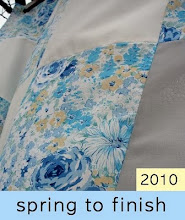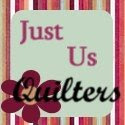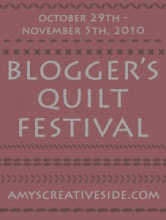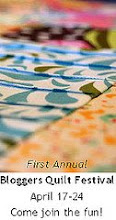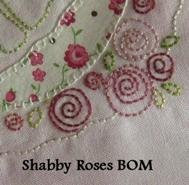 The circles are made from left-over cut-offs from my Drunkard's Path Quilt. (BTW, you can see a tutorial on using Marti Mitchell's templates for this quilt on my side board.) I actually hand-pieced the quarter circles last spring when I was visiting (and helping out a bit with) my new twin granddaughters in Boston. I machine appliqued the circles with a buttonhole stitch...you can see how I used iron-on interfacing to make this super easy to do here.
The circles are made from left-over cut-offs from my Drunkard's Path Quilt. (BTW, you can see a tutorial on using Marti Mitchell's templates for this quilt on my side board.) I actually hand-pieced the quarter circles last spring when I was visiting (and helping out a bit with) my new twin granddaughters in Boston. I machine appliqued the circles with a buttonhole stitch...you can see how I used iron-on interfacing to make this super easy to do here.Sunday, October 30, 2011
Blogger's Quilt Festival: Fall 2011
 The circles are made from left-over cut-offs from my Drunkard's Path Quilt. (BTW, you can see a tutorial on using Marti Mitchell's templates for this quilt on my side board.) I actually hand-pieced the quarter circles last spring when I was visiting (and helping out a bit with) my new twin granddaughters in Boston. I machine appliqued the circles with a buttonhole stitch...you can see how I used iron-on interfacing to make this super easy to do here.
The circles are made from left-over cut-offs from my Drunkard's Path Quilt. (BTW, you can see a tutorial on using Marti Mitchell's templates for this quilt on my side board.) I actually hand-pieced the quarter circles last spring when I was visiting (and helping out a bit with) my new twin granddaughters in Boston. I machine appliqued the circles with a buttonhole stitch...you can see how I used iron-on interfacing to make this super easy to do here.Tuesday, October 25, 2011
Tuesdays Tomes: Oops! my iPod died
Friday, October 21, 2011
Happy Circle Quilt
 When I was in Boston last spring, I hand pieced the quarter circles I had left over from cutting my yellow and white Drunkard's Path quilt but I hadn't done anything with the circles. I was thinking about it however.
When I was in Boston last spring, I hand pieced the quarter circles I had left over from cutting my yellow and white Drunkard's Path quilt but I hadn't done anything with the circles. I was thinking about it however.  Then I sewed with a 1/4" seam allowance around the circles, trimmed the interfacing, and carefully slit the back of the interfacing.
Then I sewed with a 1/4" seam allowance around the circles, trimmed the interfacing, and carefully slit the back of the interfacing. Then I turned the circles out...
Then I turned the circles out... and laid them on red and white striped square and pressed. The iron-on interfacing held well enough that I could sew them (using a buttonhole stitch) without any pins.
and laid them on red and white striped square and pressed. The iron-on interfacing held well enough that I could sew them (using a buttonhole stitch) without any pins.
 The circles were about 9" and I played around a bit with the size of the striped square until I decided I liked a square that would finish at 11". (Any bigger and I thought the red was too dominant.)
The circles were about 9" and I played around a bit with the size of the striped square until I decided I liked a square that would finish at 11". (Any bigger and I thought the red was too dominant.) Then I started playing with them on my design wall and I liked them off-set. It just added to the fun.
Then I started playing with them on my design wall and I liked them off-set. It just added to the fun. So I sewed it all together with sashing that finished at 3", then added a 3" outer border in white too and a fun red and yellow 3" square outer border.
So I sewed it all together with sashing that finished at 3", then added a 3" outer border in white too and a fun red and yellow 3" square outer border. I'm linking to Finished for Friday at Lit and Laundry and to Can I Get a Whoop Whoop. Hop on over and see all the terrific stuff happening.
I'm linking to Finished for Friday at Lit and Laundry and to Can I Get a Whoop Whoop. Hop on over and see all the terrific stuff happening.Tuesday, October 18, 2011
Tuesdays Tomes: The Calico Cat by Charles Miner Thompson

The Calico Cat by Charles Miner Thompson
Mr. Peaslee and his wife moved into town from their farm one year ago and ever since he has been tormented by a rascally calico cat who likes his hen house. He’s convinced that this calico cat is the smartest, most annoying cat ever: a cat that delights in making him miserable.
When he’s full of his good news-he’s been called to serve on the county Grand Jury and pictures himself serving with wisdom and great dignity, he sees that calico cat sitting on the fence. He’s certain that cat is mocking him and he goes a little crazy. He tries to shoot it!
Now don’t worry, the cat is fine but the ramifications of that shot go far.
This hilarious, generous hearted tale of a small American village on the Canadian border is filled with wonderful characters.
A first novel (1908) by Charles Miner Thompson with illustrations by F.R. Gruger, this story first appeared in The Youth’s Companion, a family magazine (1827-1929). BTW, Francis Bellamy who wrote the Pledge of Allegiance in1892 (it was adopted by Congress in 1942) was a staff writer at The Youth’s Companion.
Charmingly read by Allyson Hester, you can download this free audio-book here or the free e-book in pdf., e-Pub or Kindle format here.
Tuesday, October 11, 2011
Tuesdays Tomes: The Shadow of the Rope by E.W. Hornung

The Shadow of the Rope by E.W. Hornung
Romance? Mystery? While its hard for me to assign this book a genre, it is easy for me for say how delightful it is.
Young Rachel, alone in the world, jumps at the opportunity to travel from
Acquitted of the murder by the jury but not by public opinion, Rachel finds herself penniless and alone. White-haired Mr. Steel, who sat everyday at her trial, offers his assistance. She is hesitant- why would this man, a perfect stranger, want to help her? She has heard of other women, acquitted of horrible crimes, that are later besieged by marriage offers…is this his intention?
She accepts his help because she truly has no other choice, and because he clearly states that she will have her own rooms at a respectable hotel. The next morning he does propose marriage-a completely platonic one. His explanation of why wants to marry her is one of the delights of this book.
“I want a wife; or rather, my neighbors seem bent upon finding me one; and, if the worst has to come to the worst, I prefer to choose for myself. Matrimony, however, is about the very last state of life that I desire, and I take it to be the same with you. Therefore--to put the cart before the horse--you would suit me ideally. One's own life would be unaltered, but the Delverton mothers would cease from troubling, and at the head of my establishment there would be a lady of whom I should be most justly proud.”
Take that, Mrs. Bennet!
What should Rachel do? Considering her last hasty marriage, you would think she would give Mr. Steel’s offer a pass but she is truly friendless. They marry and after a tour of Europe, they return to his large estate in
The
“The novels of Charles Langholm were chiefly remarkable for their intricate plots, and for the hope of better things that breathed through the cheap sensation of the best of them.”
I had to wonder if the author was thinking of himself but my favorite comment is yet to come.
"What!" he cried; "you call yourself a lady, and you don't look at the end before you reach it?"
Ahh, from now on, I will not feel guilty when I peek at the end of a book.
That’s it for now…you’ll have to read this 1902 novel to find out more about Rachel and Mr. Steel. This is the second novel by E.W. Hornung (brother-in-law of Sir Arthur Conan Doyle) that I’ve read and I liked it even more than the first. (You can read that review here.)
Read by Christine DuFour, you can download this free audio-book here or the free e-book in pdf., e-pub., or Kindle format here.


Friday, October 7, 2011
Home Again: views from Hannover and the Harz Mountains
 It is the most powerful Holocaust Memorial I have ever seen-each person's name, age or date of birth and place and date of death is inscribed on the sloping sides. They finally have a gravestone.
It is the most powerful Holocaust Memorial I have ever seen-each person's name, age or date of birth and place and date of death is inscribed on the sloping sides. They finally have a gravestone. I think I went to every museum in Hannover-large and small. Here are just two of the wonderful things I saw that I wanted to share: a pair of antique dolls ( taken through the glass case).
I think I went to every museum in Hannover-large and small. Here are just two of the wonderful things I saw that I wanted to share: a pair of antique dolls ( taken through the glass case). Most evenings we went out to dinner with other conference participants-it was nice to finally meet many people that I've heard Dan talk about for years. We did go to the opera one night (The Marriage of Figaro) and this is the door knob of the Opera House! Pretty cool!
Most evenings we went out to dinner with other conference participants-it was nice to finally meet many people that I've heard Dan talk about for years. We did go to the opera one night (The Marriage of Figaro) and this is the door knob of the Opera House! Pretty cool! Saturday, the conference organized a trip to the Harz Mountains (bird seed, anyone?). I've discovered that the Harz Mountains are really a plateau of rolling hills and
Saturday, the conference organized a trip to the Harz Mountains (bird seed, anyone?). I've discovered that the Harz Mountains are really a plateau of rolling hills and beautiful forests.
beautiful forests. We made a friend...isn't he gorgeous!
We made a friend...isn't he gorgeous! The trip was organized around Leibniz, of course. Besides math and philosophy, he was interested in industry and general problem solving. The silver mines in the Harz Mountains had terrible problems with water in the mines...the solution was to use water wheels to run the pumps to get the water out! Leibniz thought he had a better way-windmills-or at least a closed water system that then utilized the water pumped from the mines to run the water wheels. It wasn't actually put into practice at the mine he worked with but both were later used at another mine.
The trip was organized around Leibniz, of course. Besides math and philosophy, he was interested in industry and general problem solving. The silver mines in the Harz Mountains had terrible problems with water in the mines...the solution was to use water wheels to run the pumps to get the water out! Leibniz thought he had a better way-windmills-or at least a closed water system that then utilized the water pumped from the mines to run the water wheels. It wasn't actually put into practice at the mine he worked with but both were later used at another mine.  sluice and pump house.
sluice and pump house. And a real water wheel...look at the size of it!
And a real water wheel...look at the size of it! How did they get enough water to run the water wheels? They dug channels to bring water from higher, more distant mountains-these covered miles and miles-
How did they get enough water to run the water wheels? They dug channels to bring water from higher, more distant mountains-these covered miles and miles- and they created reservoirs to collect the water from local streams and creeks-creating lastingly beautiful places.
and they created reservoirs to collect the water from local streams and creeks-creating lastingly beautiful places. Now that we're back, Tuesdays Tomes will resume-I definitely had no time to read on our trip!
Now that we're back, Tuesdays Tomes will resume-I definitely had no time to read on our trip!Monday, October 3, 2011
Hannover: Gardens and Bricks
 Here you can see one of the formal mazes-with two special Hannover differences: 1) flowers and 2) the maze is cut very low (those aren't mutant giant flowers!)
Here you can see one of the formal mazes-with two special Hannover differences: 1) flowers and 2) the maze is cut very low (those aren't mutant giant flowers!) Our hotel was in the old quarter and right down the street was the Old Town Hall...the streets were too narrow for me to get a picture of the whole building so this is from the internet.
Our hotel was in the old quarter and right down the street was the Old Town Hall...the streets were too narrow for me to get a picture of the whole building so this is from the internet. Isn't that quite an amazing brick building? I just love the crazy high frontage. This is the most southern building in Germany done in the North German Brick Gothic style. Parts of the building date from 1410.
Isn't that quite an amazing brick building? I just love the crazy high frontage. This is the most southern building in Germany done in the North German Brick Gothic style. Parts of the building date from 1410. Historians don't know why this was added into the brick work on the side wall...maybe this is how the townsfolk felt about the local government!
Historians don't know why this was added into the brick work on the side wall...maybe this is how the townsfolk felt about the local government!







